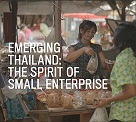Rubber Farmer

In this Photo:
The DVD showcases a seller in a Chachoengsao province marketplace.
Rubber is harvested mainly in the form of latex from the Para rubber trees. The latex is a sticky, milky solution drawn by making incisions into the tree bark and collecting the fluid that runs off. This process is called "tapping." About 42 percent of rubber produced in the world is natural rubber. Though rubber trees were indigenous to South America, in the late 19th century seeds were germinated in several Asian countries. Today, Asia is the main source of natural rubber, accounting for 94 percent of its output. Thailand is one of the largest rubber producing countries, with rubber production most prevalent in the southern part of the country.
Tapping normally takes place early in the morning when the internal pressure of the tree is at its highest. The latex drains into a spout knocked into the bark and is collected by the half shell of a coconut. The trees will drip latex for about four hours. After the rubber is collected, it is transferred to coagulation tanks and later rolled into ribbed 2-foot-by-3-foot sheets, which are air dried and then sold to manufacturers.
The rubber farmer in the film begins tapping at 2 a.m. It takes about two hours for her to finish her trees and then she rides on her motorbike to another plantation where she taps trees. About 7 a.m. she begins collecting the drained latex at her own farm and then returns to the other plantation. She's usually done by 10 a.m. The family's main source of income is her husband's job in construction. The farmer used to work as an x-ray technician in a hospital but decided to become a rubber farmer so that she could spend more time at home. The biggest problem with rubber farming, she says, is that there is no production—and consequently no income— during the dry months of March and April and during periods when there are heavy rains.